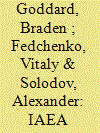| Srl | Item |
| 1 |
ID:
153901


|
|
|
|
|
| Summary/Abstract |
The International Atomic Energy Agency uses a concept of “significant quantity” to establish accounting limits and to determine how much nuclear material can be unaccounted for before the construction of a nuclear device becomes possible. Under the current SQ values, some materials could potentially be under-regulated, while others have disproportionately tight accounting practices, thus interfering with optimal safeguards efficacy. This article compares the SQ values of various materials and reviews the categories adopted by a variety of national regulators to show similarities and differences of approaches. The article concludes by offering possible solutions to increase safeguards efficacy and reduce costs, while acknowledging potential drawbacks. All findings and conclusions are based on open-source publications and publicly available information.
|
|
|
|
|
|
|
|
|
|
|
|
|
|
|
|
| 2 |
ID:
157475


|
|
|
|
|
| Summary/Abstract |
Phosphate rocks are predominantly mined for fertilizer production. However, they also contain considerable amounts of accompanying natural uranium that can exceed concentrations found at commercial uranium mines. Extracting uranium from phosphate rocks during fertilizer production is a technically mature process; it was used on an industrial scale in the United States and elsewhere before decreasing uranium prices made this practice unprofitable in the 1990s. Soon, technical improvements, potentially rising uranium prices, and anticipated environmental regulations may make uranium extraction from phosphates profitable again in the United States and emerging phosphate rock mining centers in Northern Africa and the Middle East. Extracting uranium during phosphate fertilizer production is desirable in a way that otherwise lost resources are conserved and fertilizers with reduced radiotoxic heavy metal content are produced. Phosphate rocks have also been subject to clandestine uranium acquisition. In this work, the relevance of unconventional uranium resources from phosphate rocks is reviewed. A brief overview of the extraction process, a list of the required materials, and a very simple estimation of the amounts of uranium that could be extracted using a container-sized pilot plant which can be integrated into existing fertilizer plants is provided. Lastly, past known unreported uranium extraction activities from phosphate rocks are discussed.
|
|
|
|
|
|
|
|
|
|
|
|
|
|
|
|
| 3 |
ID:
080560


|
|
|
|
|
| Publication |
Oxford, Oxford University Press, 2007.
|
| Description |
ix, 136p.
|
| Series |
SIPRI research report; No. 22
|
| Standard Number |
9780199290864
|
|
|
|
|
|
|
|
|
|
|
|
Copies: C:1/I:0,R:0,Q:0
Circulation
| Accession# | Call# | Current Location | Status | Policy | Location |
| 052949 | 327.1747/ANT 052949 | Main | On Shelf | General | |
|
|
|
|
| 4 |
ID:
129742


|
|
|
|
|
| Publication |
2014.
|
| Summary/Abstract |
The purpose of the nuclear security regime is to prevent, detect and respond to nuclear security events (e.g. illicit trafficking of nuclear material or a nuclear terrorism attack). Nuclear forensic analysis is a key technical capability that utilises signatures inherent to nuclear or other radioactive material to provide information on its source, production and history. It can be used as part of the response to the nuclear security event, as well as to help prevent it. Section I of this article will introduce the basic information about nuclear forensic analysis. Section II, which constitutes the main body of the article, will describe in detail how the process of nuclear forensic analysis works in case of a nuclear security event investigation, and provide examples to illustrate specific points. Section III will conclude the article by discussing how nuclear forensics can be utilised not just for a post-event investigation but also for prevention of nuclear security events.
|
|
|
|
|
|
|
|
|
|
|
|
|
|
|
|
| 5 |
ID:
019426


|
|
|
|
|
| Publication |
Summer 2001.
|
| Description |
19-24
|
|
|
|
|
|
|
|
|
|
|
|
|
|
|
|